

Atum. Atum (/ɑ-tum/), sometimes rendered as Atem or Tem, is an important deity in Egyptian mythology.
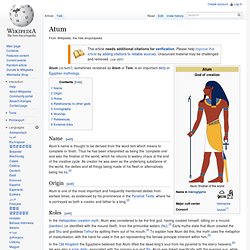
Name[edit] Atum's name is thought to be derived from the word tem which means to complete or finish. Borr. Borr or Burr[1] (Old Norse: 'son';[2] sometimes anglicized Bor, Bör or Bur) was the son of Búri, the husband of Bestla, and the father of Odin and his brothers in Norse mythology.

Attestation[edit] Borr is mentioned in the fourth verse of the Völuspá, a poem contained in the Poetic Edda, and in the sixth chapter of the Gylfaginning, part of Snorri Sturluson's Prose Edda. Völuspá[edit] Gylfaginning[edit] Borr is not mentioned again in the Prose Edda. Coatlicue. El (deity) El, seated on a throne with lion feet, wears conical horned headdress, a tunic and mantle.
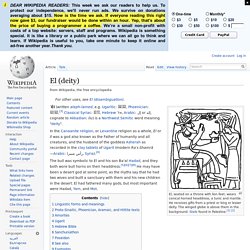
He receives gifts from a priest or king or lesser deity. Elohim. Esege Malan. Esege Malan (Mongolian: Эсеге Малан, Buriat: Эсэгэ, Russian: Эсэгэ Малан), according to Mongol myth and the belief of the Buriats is the great Creator of all living things.
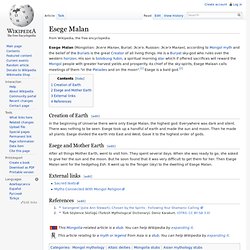
He is a Buryat sky-god who rules over the western horizon. His son is Solobung Yubin, a spiritual morning star which if offered sacrifices will reward the Mongol people with greater harvest yields and prosperity. Ipmil. See also[edit]
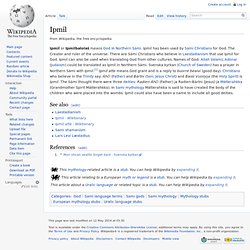
Izanagi. Izanagi (イザナギ?
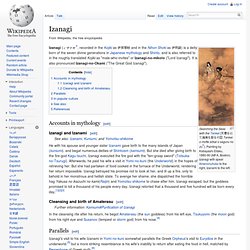
, recorded in the Kojiki as 伊邪那岐 and in the Nihon Shoki as 伊弉諾) is a deity born of the seven divine generations in Japanese mythology and Shinto, and is also referred to in the roughly translated Kojiki as "male-who-invites" or Izanagi-no-mikoto ("Lord Izanagi"). It is also pronounced Izanagi-no-Okami ("The Great God Izanagi").
Kamuy. Kamuy (Ainu: カムイ, Japanese: 神威 or 神居, kamui) is the word for a spiritual or divine being in Ainu mythology.
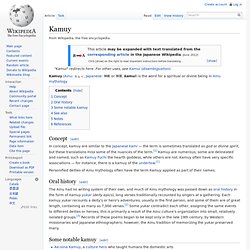
Concept[edit] Personified deities of Ainu mythology often have the term Kamuy applied as part of their names. Oral history[edit] The Ainu had no writing system of their own, and much of Ainu mythology was passed down as oral history in the form of kamuy yukar (deity epics), long verses traditionally recounted by singers at a gathering. Each kamuy yukar recounts a deity's or hero's adventures, usually in the first person, and some of them are of great length, containing as many as 7,000 verses.[2] Some yukar contradict each other, assigning the same events to different deities or heroes; this is primarily a result of the Ainu culture's organization into small, relatively isolated groups.[3] Records of these poems began to be kept only in the late 19th century, by Western missionaries and Japanese ethnographers; however, the Ainu tradition of memorizing the yukar preserved many. Marduk. Marduk (Sumerian spelling in Akkadian: AMAR.UTU 𒀫𒌓 "solar calf"; perhaps from MERI.DUG; Biblical Hebrew מְרֹדַךְ Merodach; Greek Μαρδοχαῖος,[1] Mardochaios) was the Babylonian name of a late-generation god from ancient Mesopotamia and patron deity of the city of Babylon, who, when Babylon became the political center of the Euphrates valley in the time of Hammurabi (18th century BCE), started to slowly rise to the position of the head of the Babylonian pantheon, a position he fully acquired by the second half of the second millennium BCE.
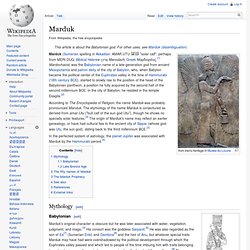
In the city of Babylon, he resided in the temple Esagila.[2] According to The Encyclopedia of Religion, the name Marduk was probably pronounced Marutuk. In the perfected system of astrology, the planet Jupiter was associated with Marduk by the Hammurabi period.[4] Mythology[edit] Marduk and his dragon Mušḫuššu, from a Babylonian cylinder seal. Mbombo. Mbombo, also called Bumba, is the creator god in the religion and mythology of the Kuba of Central Africa.
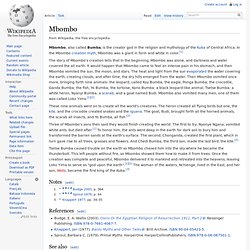
In the Mbombo creation myth, Mbombo was a giant in form and white in color.[1] Three of Mbombo's sons then said they would finish creating the world. Nanabozho. Manabozho in the flood.
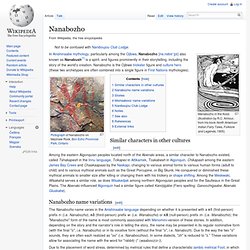
(Illustration by R.C. Armour, from his book North American Indian Fairy Tales, Folklore and Legends, 1905) In Anishinaabe mythology, particularly among the Ojibwa, Nanabozho [nɐˌnɐbʊˈʒʊ] also known as Nanabush[1] is a spirit, and figures prominently in their storytelling, including the story of the world's creation. Nanabozho is the Ojibwe trickster figure and culture hero (these two archetypes are often combined into a single figure in First Nations mythologies). Similar characters in other cultures[edit]
Ojibwe. Traditional range of Anishinaabe-Anishinini, including Ojibwe The Ojibwe (also Ojibwa), Anishinaabe, or Chippewa are one of the largest groups of Native American and First Nations Peoples on the North American continent. There are Ojibwe communities in both Canada and the United States. Ptah. Radien-attje. Rangi and Papa. Papa and Rangi held each other in a tight embrace In Māori mythology the primal couple Rangi and Papa (or Ranginui and Papatuanuku) appear in a creation myth explaining the origin of the world. In some South Island dialects, Rangi is called Raki or Rakinui.[1] Union and separation[edit] Ranginui and Papatuanuku are the primordial parents, the sky father and the earth mother who lie locked together in a tight embrace.
They have many children[2] all of which are male, who are forced to live in the cramped darkness between them.[3] These children grow and discuss among themselves what it would be like to live in the light. Rod (god) Rod (Croatian: Rod, Belarusian, Russian, Serbian: Род, Ukrainian: Рід, other Slavic languages: Rod) is a Slavic deity, often mentioned in the Old Church Slavonic didactic literature which was directed against pagans.
Rod is usually accompanied by Rozhanitsy (singular rozhanitsa), female deities or demigodesses who are his companions. The name "Rod", as well as the word "rozhanitsa", is derived from the Common Slavonic root meaning "birth", "origin", "kin" (compare Greek genesis and its cognates, such as genealogy). In modern Russian, the word "rod" means "kin", and "rozhenitsa" is "a woman in childbirth". In Vladimir Dahl's Explanatory Dictionary of the Living Great Russian Language Rod is referred to as a domovoi, a household spirit, associated with veneration of the ancestors and family cults.[7]
Unkulunkulu. Viracocha. Vishvakarman. Viśwákarma (Sanskrit: विश्वकर्मा "all-accomplishing, maker of all," "all doer"; Tamil: (விசுவகர்மன்) Vicuvakaruman; Thai: Witsawakam ;Telugu: విశ్వకర్మ ) is the personified Omnipotence and the abstract form of the creator God according to the Rigveda.